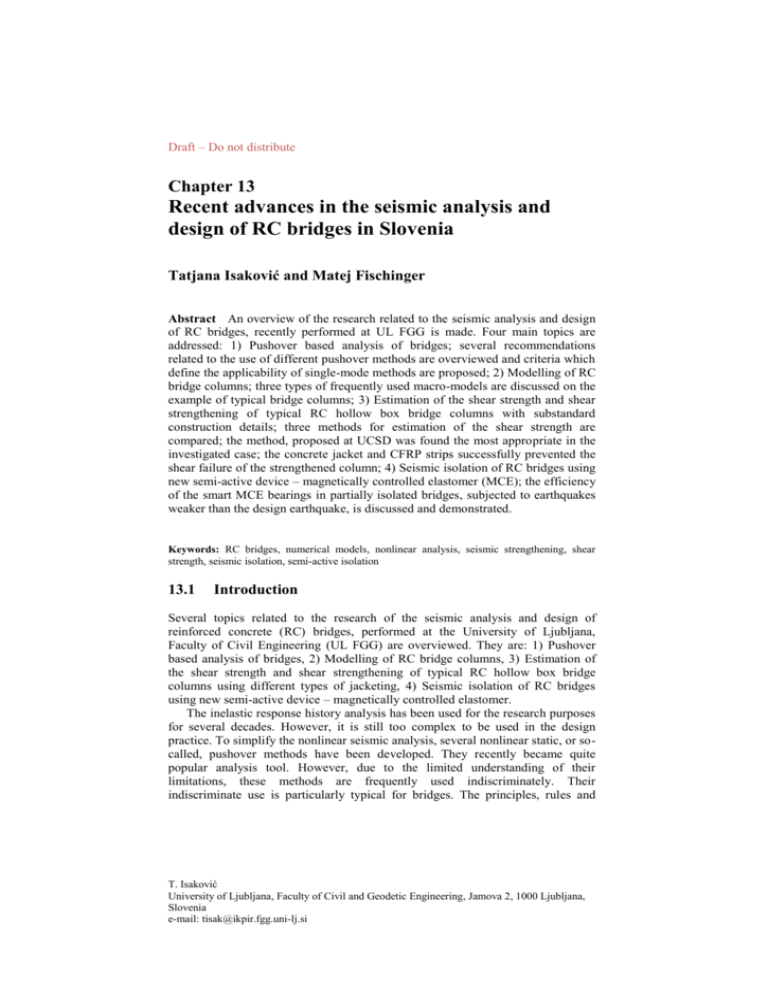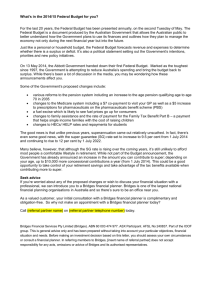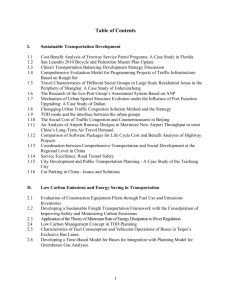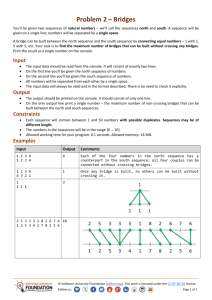sample
advertisement

Draft – Do not distribute Chapter 13 Recent advances in the seismic analysis and design of RC bridges in Slovenia Tatjana Isaković and Matej Fischinger Abstract An overview of the research related to the seismic analysis and design of RC bridges, recently performed at UL FGG is made. Four main topics are addressed: 1) Pushover based analysis of bridges; several recommendations related to the use of different pushover methods are overviewed and criteria which define the applicability of single-mode methods are proposed; 2) Modelling of RC bridge columns; three types of frequently used macro-models are discussed on the example of typical bridge columns; 3) Estimation of the shear strength and shear strengthening of typical RC hollow box bridge columns with substandard construction details; three methods for estimation of the shear strength are compared; the method, proposed at UCSD was found the most appropriate in the investigated case; the concrete jacket and CFRP strips successfully prevented the shear failure of the strengthened column; 4) Seismic isolation of RC bridges using new semi-active device – magnetically controlled elastomer (MCE); the efficiency of the smart MCE bearings in partially isolated bridges, subjected to earthquakes weaker than the design earthquake, is discussed and demonstrated. Keywords: RC bridges, numerical models, nonlinear analysis, seismic strengthening, shear strength, seismic isolation, semi-active isolation 13.1 Introduction Several topics related to the research of the seismic analysis and design of reinforced concrete (RC) bridges, performed at the University of Ljubljana, Faculty of Civil Engineering (UL FGG) are overviewed. They are: 1) Pushover based analysis of bridges, 2) Modelling of RC bridge columns, 3) Estimation of the shear strength and shear strengthening of typical RC hollow box bridge columns using different types of jacketing, 4) Seismic isolation of RC bridges using new semi-active device – magnetically controlled elastomer. The inelastic response history analysis has been used for the research purposes for several decades. However, it is still too complex to be used in the design practice. To simplify the nonlinear seismic analysis, several nonlinear static, or socalled, pushover methods have been developed. They recently became quite popular analysis tool. However, due to the limited understanding of their limitations, these methods are frequently used indiscriminately. Their indiscriminate use is particularly typical for bridges. The principles, rules and T. Isaković University of Ljubljana, Faculty of Civil and Geodetic Engineering, Jamova 2, 1000 Ljubljana, Slovenia e-mail: tisak@ikpir.fgg.uni-lj.si 2 procedures which were originally developed for buildings have often been simply extrapolated to bridges, neglecting the major differences between these structural systems and their seismic response. In Section 2 basic specifics in the application of the pushover methods for the analysis of bridges are briefly summarized, and criteria defining the applicability of the N2 method, which is included into Eurocode standards, are introduced. To perform the nonlinear analysis, adequate numerical models are needed. Some experiences obtained at UL FGG in modelling RC bridge columns are summarized in Section 3. To establish an appropriate numerical model the adequate data about the capacity of columns are needed. While the quantities defining the flexural response are usually well defined, the shear response of columns is much more difficult to predict. The knowledge related to this problem is still incomplete. This is e.g. indicated by quite large differences in the results of different methods proposed for the estimation of the shear strength and stiffness of RC columns. This problem is analyzed on the example of columns of a typical existing viaduct, which includes several construction deficiencies. Several methods for estimation of the shear strength are compared and evaluated by means of the experimental results (see Section 4). There are numerous existing bridges, which were designed before the modern principles of the seismic engineering were established. From the nowadays point of view, they include many substandard construction details which demand adequate strengthening and retrofit. One of such examples is analyzed in Section 4. Different retrofitting techniques, including concrete and FRP jacketing are analyzed on the example of a typical viaduct, built in 1970’ies. One of the possibilities for the seismic protection of new bridges as well as for the strengthening of existing structures is the seismic isolation. In the last part of Chapter (Section 5) a new semi-active seismic isolation device, magnetically controlled elastomer (MCE) is briefly introduced and the possibilities for its use in bridges are overviewed. 13.2 Simplified nonlinear analysis of bridges To simplify the inelastic analysis, and to make it more convenient for everyday design, several simplified nonlinear analysis methods have been developed. They are so called pushover methods. There are several methods of this type available. The simplest methods are so called single-mode pushover methods. One of the main assumptions of these methods is that the response of a structure is governed mostly by one predominant mode. The typical representative of this group is the N2 method [1], which is included in the Eurocode standards [2], [3]. The specifics in the application of this method for the analysis of bridges are described in Section 2.1. It is typical for long bridges (with the total length of 500 m and longer) that the response can be considerably influenced by higher modes of vibration. In those cases, the single-mode methods are less accurate, and multi-mode pushover 3 methods can be used instead. Some of the conclusions related to their applicability for the analysis of bridges are shortly overviewed in Section 2.2. 13.2.1 The N2 method – Single-mode pushover methods The N2 method was originally developed for the analysis of buildings. Therefore it should be modified when it is used for the analysis of bridges, since their structural system is considerably different than that of buildings (particularly in their transverse direction). In this Section the appropriate modifications are proposed and summarized. Further details can be found in [4] - [6]. The proposed modifications of the N2 method for the analysis of bridges are: 1) The distribution of lateral forces along the superstructure; 2) The choice of the point where the displacements are monitored to obtain the force-displacement relationship; 3) Idealization of the force-displacement curve, and calculation of yielding force and yielding displacement. 1) The distribution of the “inertial” forces (lateral load) should be assumed before the nonlinear static analysis is performed. Some of the distributions appropriate for bridges are summarized in Fig. 13.1. Note that two extreme cases of the constraints above the abutments are addressed. In the Annex H of standard Eurocode 8/2 (EC8/2) two possible distributions are proposed: a) distribution proportional to the 1st mode of the bridge in the elastic range, b) uniform distribution (see Figs. 13.1(1)a and 13.1(1)b). The first distribution can be defined based on a modal analysis with some of the standard programs for elastic modal analysis. In the previous research [5] - [6] it was found that the parabolic distribution (Fig. 13.1(1)c) is appropriate for bridges that are pinned at the abutments. This distribution is simpler to define than that proportional to the first mode. In many cases, the results of the N2 method and the inelastic response history analysis correspond better when the uniform distribution is replaced by the parabolic one. (1) (2) L L X m1 F1 ... mi i m1 Fi mi i F1 Fn Fi 1 mn n proportional to the 1st mode a) proporcionalna 1. nihajni obliki ... mi Fi mi i Fn Fi 1 mn i n proportional to trenutni the instant 1 st mode a) proporcionalna 1. nihajni obliki 1stnihajna mode oblika i – 1. – trenutna i instant 1. nihajna oblika 1st mode uniform b) enakomerna b) enakomerna uniform i = 1 i = 1 parabolic c) parabolična i 4 2 4 x x L L2 Fig. 13.1 Distributions of the lateral load, appropriate for bridges that are: 1) pinned at the abutments, 2) with roller supports at the abutments 4 Table 13.1 Advantages and limitations of the presented elements Type of Element Advantages Limitations BeamColumn Element with Lumped Plasticity Simple model with small number of elements (often one per column) Non-linearity defined based on the hysteretic rule with clear physical meaning Easy to control Cannot be used for the analysis of coupled bi-directional response Unable to estimate stresses and strains Fibre Element Able to estimate strains and stresses Can be used for the analysis of bidirectional response Relatively complex analysis Several iterations are necessary to establish the appropriate model Control of results is more complex MVL Element Relatively simple Non-linearity defined based on the hysteretic rule with clear physical meanings Able to estimate strains and stresses Can be used for analysis of bidirectional response In general, several elements per column are necessary to obtain acceptable estimation of the response Appropriate number of elements should be defined iteratively OL S15 33.3 S16 34.0 S17 34.0 S18 34.0 S19 34.0 S20 34.0 S21 34.0 S22 34.0 S23 S24 34.0 34.0 591.4 m S25 34.0 S26 37.7 S27 37.7 Fig. 13.13 Typical existing viaduct with substandard construction details S28 37.7 S29 34.0 S30 OD 37.7 33.3 5 References 1. Fajfar P (2000) A nonlinear analysis method for performance-based seismic design. Earthquake Spectra 16:573-592. 2. CEN (2004) Eurocode 8: Design of structures for earthquake resistance. Part 1: General rules, seismic action and rules for buildings. EN 1998-1, Euro Commit for Stand, Brussels, December 2004 3. Kanaan A.E., Powell G.H. (1973) A general purpose computer program for dynamic analysis of planar structures, , Report UBC/EERC-73/6, Univ. of California, Berkeley. 4. McKenna F, Fenves GL (2007) Open system for earthquake engineering simulation, Pacific Earthquake Engineering Research Center, Berkeley, California, http://opensees.berkeley.edu 5. Prakash V., Powell G.H., Filippou F.C. (1993) DRAIN-3DX: Base program users guide, Department of Civil Engineering, University of California, Berkeley, USA. 6. Vulcano A., Bertero V.V., Caloti V. (1989) Analytical modelling of R/C structural walls, Proceedings of the 9th WCEE, Tokyo-Kyoto, Maruzen, Vol. 6, pp. 41-46. 7. Fischinger M., Vidic T., Fajfar P. (1992) Non-linear seismic analysis of structural walls using the multiple-vertical-line-element model, Non-linear Seismic Analysis and Design of Reinforced Concrete Buildings, Elsevier, Bled, Slovenia, pp.191-202. Keywords: Bridges, RC bridges, nonlinear analysis, simplified nonlinear analysis, static nonlinear analysis, pushover methods, single mode pushover methods, multi mode pushover methods, applicability of pushover methods, N2 method, MPA, IRSA, RC columns, numerical model, nonlinear response history analysis, flexural response, macro models, beam-column elements with lumped plasticity, fiber element, multiple vertical line element, MVLEM, Takeda hysteretic rules, seismic strengthening, concrete jacketing, CFRP, CFRP strips, shear strength, shear strengthening, existing bridges, substandard construction details, experiment, hollow box columns, Eurocode 8, EC8/2, EC8/3, EC2, Eurocode 2, UCSD method, shear failure, buckling of the longitudinal bars, seismic isolation, rubber bearings, elastomeric bearings, semi-active isolation, magnetically controlled elastomers, MCE, MCE bearings, partial isolation, weak earthquakes






